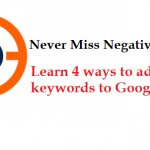Ecommerce SEO Guide
Ecommerce SEO is often ignored by the owners. This may be because of the ignorance towards the importance of SEO.
Or
Because they are not acquainted well with “how to do SEO for ecommerce website”.
To learn the general SEO FAQs read the post here.
And, to learn the advantages and steps of ecommerce SEO continue reading.
But before digging in deep, let us first refresh ourselves about ecommerce definition.
Ecommerce or Electronic Commerce means:
commercial transactions conducted electronically on the Internet
This means that when you buy or sell services or products, or, transfer data or funds through an electronic medium, mainly internet. Then it means you are on an ecommerce platform.
The basic mantra to remember for high ranking and visibility in organic searches on the search engines is that
“Ethical SEO will definitely take time for most competitive search queries”
But if you do not want to wait and want quick results then…
…paid marketing is the done deal for you.
Although if…
You are not in a rush and have time for organic SEO, then it can reward you greatly. Infact as per MarketingCharts 39% of the customers for the online merchants are driven from search engines.
This is huge.
As an ecommerce website design company in Delhi-India we have listed the checkpoints for your consideration to achieve best results for organic search engine optimization.
Ecommerce SEO Checklist
First thing first.
Since SEO is mainly for the search engines so do not miss to set up the leading search engines webmasters tools.
To mention a few:
Why?
Although there are many uses of installing a webmaster tool in SEO.
But to mention a few:
- Keyword searching
- Site errors
- 404 errors identification
- Duplicate content
- Knowing the search traffic, and many more
Do not forget to:
Create and submit an xml sitemap of your ecommerce site to the search engines. Make sure to check the account from which you are submitting.
Keyword Research for Ecommerce SEO
This is the main step to establish any SEO strategy. Do a thorough research to find the most searched for keywords for the products on your ecommerce website.
There are many tools which can help you identify and choose depending on the search volume of the keywords and phrases.
Some tools which can be of great help are:
And many more such tools can be found on the internet.
You can also use Amazon for keyword research.

Just type in a word related to the product you want to search.
And boom…
…you will see multiple suggestions related to that keyword.
Whatever method, whichever tool you use to find the right keyword for you. Just remember it’s a no-rush episode and even if it consumes time, it is worth it.
On-Page Optimization
As an ecommerce service provider we have noticed that some eCommerce companies do not pay much attention to their site’s on-page optimization.
This is not right.
The standard page optimization strategy should be followed for ecommerce websites also.
Header tags
The header tags are used to distinguish the <headings> from the rest of the content on the page.
The most used header tags in SEO are h1, h2 and h3.
The <h1> tag designates the main heading of the product page or any other page.
Important: a page should have only one <h1> tag. And it should be used before the other header tags i.e. <h2> <h3>…
After all it has been given the number 1 for some reason.
If you are using a woo commerce to develop your ecommerce website then learn how to use WordPress here
Meta Content
The meta content on any given page includes meta title and meta description about that page.
This is a very useful information for the search engines as they display the meta title and description when your product page is displayed in the search results.
You can install SEO plugin like Yoast to get a sorted place to add the meta content.
It will also warn you about the length of the meta content, and the page slug or page URL.
Meta Title: under 70 characters
Meta Description: under 150 characters
Product Page URL: make sure it has the targeted keyword and is not very long. Avoid using _ (underscore) in the url.
If you are using images in your ecommerce site then do not forget to optimize them by adding alt-text and description.
Also try to include the keyword in the image title, alt-text and description for result oriented ecommerce SEO.
Link Building Strategy
Link building is the process of getting quality and authoritative websites to link back to your website.
In other words
Search engines like Google see them as votes for confirming your ecommerce site’s authority.
So for ecommerce optimization,
…the higher the number of backlinks, the higher is the percentage of a search engine to rank it above other ecommerce sites with lower backlinks.
As a part of your ecommerce SEO strategy, competitor analysis cannot be ignored. Use tools like Open Link Profiler to research about the websites who are linking to your competition stores/websites.
Contact these sites and get a link to your ecommerce website as well.
Get high quality backlinks from the media. Shopify explains the details to get the links from press here.
Read the complete guide to off-page SEO.
Content Strategy
As an experienced ecommerce SEO agency we would second the very famous and well known saying…
“Content is the king”
It was, is and will always remain true.
Keyword Research is great.
But what if you are not using it wisely in your content. You need to have a well-developed content strategy to optimize your ecommerce website for SEO.
Maintain atleast 250 word length as a product description. But if you are writing an informative page like a Blog post then it should be atleast 500 words long.
For an effective SEO strategy never stuff your page with keywords.
This is bad, just bad.
Use LSI keywords in your content for search engines to find an attaching description about your page’s content.
Duplicity in content is a strict no-no for ecommerce SEO services. Write original content for the description of the products on your ecommerce website.
Do not straight away copy the product description from the manufacturer’s site. This is also considered as duplicate content. Even if you are displaying the manufacturer’s product on your site.
If you have to use similar content on more than one product page…
…then using Canonical tag will be a good idea.
When strategizing SEO for ecommerce websites, product reviews are also an important input.
Consider adding some genuine reviews to your product page. This way not only increase the weightage of the page but also add more content to your page.
Hence, a win-win situation.
Being in ecommerce business you must have crossed a situation where the product is no longer available.
In this scenario, do not straightway delete the product.
But first set up a 301 redirect for that product to either the parent page or the homepage. So that any indexed page gets redirected to a working page.
Add Blog Posts
It’s a good SEO practice to add blog posts related to the products listed on your ecommerce website.
For instance:
If one of the product on your ecommerce site is bicycle. Then you can write about “Health benefits of riding a bicycle” or “Go green with bicycle riding” and more such topics.
Set up Business Profiles
Create your business profile on social networking sites like Facebook, Twitter, Google, and LinkedIn. If possible consider using your brand’s name such that it appears in the URL.
For instance:
www.example.com/yourcompanyname
Also create business profiles on sites where reviews can be posted. A few such sites to mention are:
Amazon, Google Business, Yelp, FourSquare, TrustPilot, and Epinions
Not only do they benefit your ecommerce website by backlinking to it. But also ranks better for search queries like “your company name Reviews”.
Responsive Ecommerce websites
It’s a must these days to make your store responsive.
That means it should give a clean, easy to navigate and user friendly look on all the devices.
If you are not sure how your website looks on all devices, you can test it here.
Speed test
Page speed test is one of the Google ranking factors for ecommerce optimization. Check your store’s speed on search engines using various tools available online.
SSL Certificate
Making your website https is imperative for e commerce websites. This is because critical information like credit or debit card number or account number is used for completing the transactions.
For better search engine rankings and to gain users trust making you ecommerce website secured is extremely important.
Concluding Ecommerce SEO
This post has covered the answer to the commonly asked question “how to optimize ecommerce website”.
As already mentioned gaining organic results by optimizing your website is a slow process. So wait patiently, especially if your brand is new in the market, for the results to show up.
Keep getting quality backlinks, create keyword oriented content, build relationships, and start writing blog posts.
For any further information or for getting your website’s SEO a kick start contact our ecommerce SEO expert.





